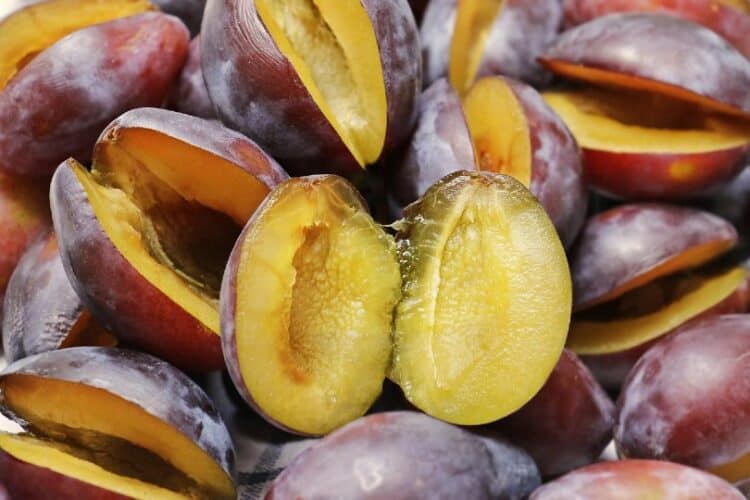As dog owners, we love offering treats to our pups. And let’s face it—dogs eat anything they can get their paws on. One drop of food scrap on the kitchen floor and your dog has swallowed it before you know it’s gone.
For this reason, dog owners everywhere want to know if plums are okay to offer as treats. The short answer? It depends.
Of course, that’s never a good enough answer, so let’s talk about what happens when dog’s eat plums and if your dog is safe after eating one.
What Happens When a Dog Eats a Plum?
The ASPCA lists plums (Prunus domestica) as toxic to dogs, cats, and horses. Other fruits like peaches, cherries, and apricots fall into this category.
The stems, leaves, and seeds in these plants contain cyanide, a fast-acting chemical that can be deadly in certain doses.
The fruit’s flesh contains much less cyanide and is mostly water, so it’s okay if your dog eats only the flesh. It’s the stems, leaves, and pit to watch out for. If your dog has recently eaten a plum pit, stem, or leaf, you should call your veterinarian as soon as possible.
Cyanide Poisoning in Dogs
Scoping out cyanide poisoning in your dog depends on how much of the plum your dog eats, how big your dog is, and how long ago your dog ate the plum. Usually, dog owners notice the signs within 15–20 minutes. More severe symptoms take a little longer to show.
Some signs of cyanide poisoning in dogs include:
- Red mucous membranes
- Dilated pupils
- Difficulty breathing
- Salivation
- Panting
- Shock
- Dizziness
- Vomiting
- Restlessness
- Weakness
More severe symptoms of cyanide poisoning include:
- Convulsions
- Loss of Consciousness
- Low blood pressure
- Respiratory failure
- Slow heart rate
So, should you be concerned if your dog only ate the plum flush? Not really. A few bites of plum flesh won’t kill your dog. It’s unlikely your dog will experience the more severe symptoms of cyanide poisoning after eating the flesh of one or two plums.
However, it’s always good to be on the safe side, so monitor your dog for any of the above symptoms.

What Other Fruits Can Dogs Eat?
You want to be wary of offering too much fruit to your dog. We all know that fruit is high in sugar, so giving these treats to your pup regularly can put them at risk for diabetes, obesity, and other medical concerns. However, fruit is low in fat, making it an excellent snack for weight loss.
Some fruits that your dog can eat are:
- Apple
- Banana
- Blueberry
- Cantaloupe
- Cranberry
- Cucumber
- Mango
- Oranges
- Peach (like plums, only peach flesh is okay to feed your dog!)
- Pear
- Pineapple
- Pumpkin
- Strawberry
- Raspberry
- Watermelon
Unsafe Fruits for Dogs
A good rule of thumb is to avoid fruits that have pits, or at least be willing to make special preparations with these fruits.
Avocado is an example of a fruit (yes, it’s a fruit!) you need to be careful with. The leaves, bark, seeds, skin, and pit all contain persin, a chemical that causes vomiting and diarrhea in dogs.
The flesh of the avocado is fine, but it can cause gastrointestinal upset and weight gain, so proceed with caution!
Grapes and raisins are other fruits to keep away from your dog. These fruits can cause kidney damage, but no one knows how many grapes it takes to make a dog ill. Because of this, it’s best to take your pet to the vet immediately if they eat a grape or raisin.
Tomatoes also make it on this list. However, tomatoes aren’t as toxic as the other fruits listed. A fully ripened tomato is fine to feed your dog in moderation. The green parts of the tomato contain solanine, which is also toxic to dogs and should be avoided.
Wrapping It Up
We love feeding our dog treats, but we have to take responsibility and figure out which foods are safe and which ones are unsafe. So, proceed with caution if you want to feed your dog a plum. Just make sure they don’t eat the stem, leaves, or pit.
Featured Image Credit: Pixabay














